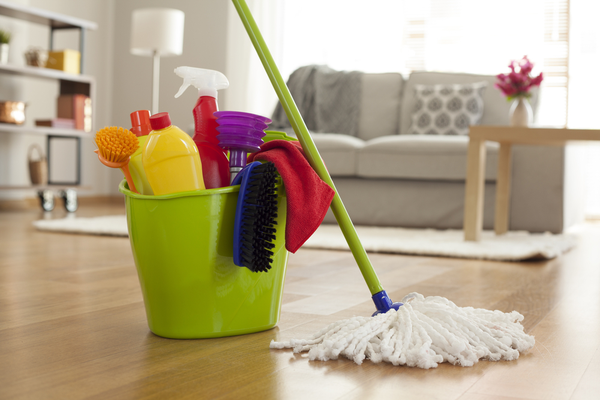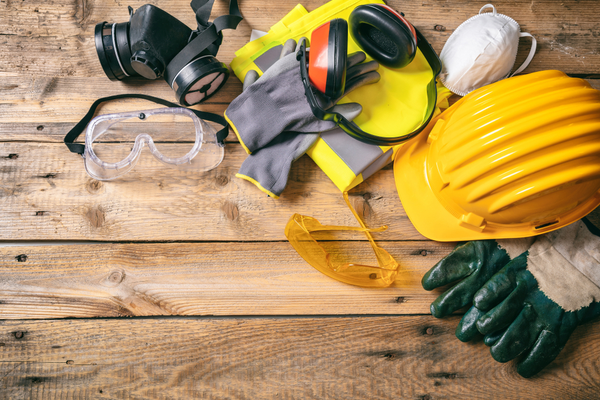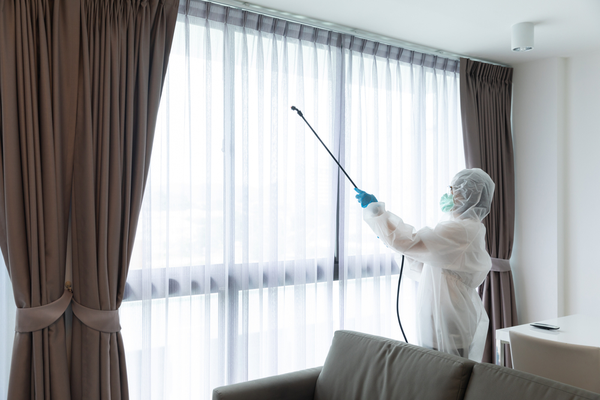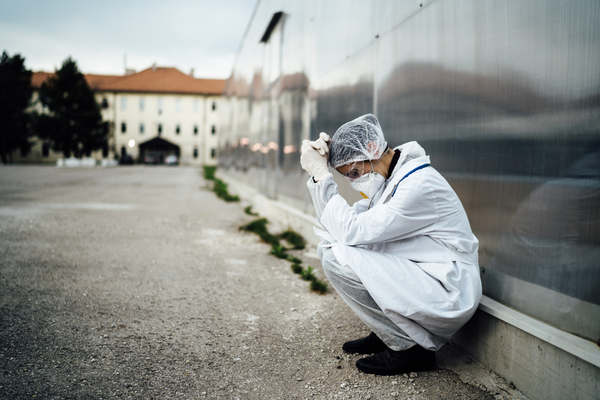Traumatic events can sometimes leave behind biohazardous material that must be removed before someone can safely enter the area. Professional crime scene cleaners can completely remove dangerous material and sanitize surfaces to restore affected areas. Because of legal certification requirements, it is not a good idea to use a regular cleaning service to clean up a traumatic scene because they are potentially breaking the law by not disposing of the hazardous materials properly.
Professional crime scene cleaning is different than regular cleaning services because they remove hazardous waste legally, use commercial-grade products, require specialized training, and thoroughly sanitize the area in a way that just isn’t possible with regular cleaners. Because crime scene cleaners require specialized products and equipment, a major difference between the two services is that crime scene cleaning costs a lot more.
Although it costs more, crime scene cleaners are the ONLY way to fully sanitize a room or building. Choosing anything else opens up the possibility of contamination and disease. Let’s look at the main reasons why the two services are different and how crime scene cleaners are the only choice for cleaning up a traumatic scene with hazardous material.

Range of Services
Regular cleaning services offer services ranging from decluttering to deep cleaning depending on the needs of the client. They tackle things like dust, dirt, and grime that can accumulate in a home or anyplace else the client needs cleaned. They can disinfect areas and surfaces, but they cannot effectively remove biohazardous material with regular products and equipment.
While they can be very thorough and clean a variety of things, regular cleaning services simply do not have the resources or experience necessary to handle any crime scene or biohazardous waste properly without leaving behind any dangerous material.
Crime scene cleaning services go beyond regular cleaning and can restore places to a safe environment that no longer pose a risk to those near it. They can completely remove the hazardous waste and harmful pathogens left behind from scenes involving crime, accidental deaths, unattended deaths, suicides, meth labs, tragedy, hoarding, decomposition, and any others that involve hazardous waste like blood.
Specialized Training
Regular cleaning crews generally have very little training because people usually have experience cleaning their own homes. They might need to learn a few techniques and how to use certain products to do the job, but otherwise it’s a pretty cut and dry business.
Some regular cleaning services are hired to handle hoarding which requires a different knowledge and process, but this is highly discouraged because regular cleaners can’t provide the complete sanitation necessary after the area is cleared out. This is where crime scene cleaners excel and have specialized training for, which makes them the only way to fully accomplish a hoarding cleanup.
While crime scene cleaners don’t usually require a degree for the position, they have to complete a very thorough training process in order to handle this type of job. A lot of crime scene cleaning companies offer OSHA training and other types of preparation like bloodborne pathogen training, personal protective equipment (PPE) training, hazardous communication cleaning, heat-illness awareness training, medical waste handling and transporting training, and respiratory protection training.
A lot of crime scene cleaning companies also require their employees go through biohazard training that sometimes is taught using mock crime scenes. They use organic and non-organic material to train cleaners to handle every step of these situations from the initial assessment of the scene to the decontamination station where they clean up after the job.
Cleaning Products
The types of cleaning products used are an importance difference between regular cleaning and crime scene cleaning services because regular products like bleach are simply not powerful enough to fully sanitize every corner of a crime scene.
Crime scene cleaners use specialized cleaning formulas to tackle this job. One of the products they use is an enzyme cleaner specifically made to liquify blood and kill pathogens. They also use hospital-grade detergents and industrial-strength deodorizers. All of these things are absolutely necessary to fully extract biohazardous material, sanitize surfaces like floors and countertops, and remove residual odor.
Equipment
Specialized equipment is the only way to safely complete a hazardous cleaning job, which are sometimes inaccessible to regular cleaning services. Regular cleaners don’t go very far beyond the typical house cleaning items that non-professionals use, like rubber gloves and vacuum cleaners.
For crime scene cleaners, equipment is absolutely vital for keeping them safe against the array of harmful pathogens and objects that they come into contact with when cleaning if unprotected. The specialized equipment that crime scene cleaners use is called personal protective equipment (PPE). This includes the protective suit, filtered respirators, chemical spill boots, and rubber gloves. These items are for one-use only, so they are disposed of along with the rest of the hazardous material at the end of a job.
Some other things that crime scene cleaners use for cleanups are ladders, shovels, long-reach brushes, putty knives, and cutting tools. Cutting tools are necessary to remove affected material like padded fabric and carpet.
Professional cleaners will use equipment like ozone machines to eliminate odors after the cleanup has been finished. They may also use vapor steam cleaners to reach hard-to-reach places and foggers which helps chemicals get into tiny spaces like cracks in the floors.
Lastly, professional crime scene cleaners need to have proper disposal containers so they can remove the hazardous material not only safely, but legally. Many regular cleaning services do not have access to these.
Procedure
The crime scene cleaning process goes well beyond cleaning of surfaces and removal of hazardous waste. They must also deal with the residual effects of the event like odor or biohazardous material seeping into other places, like liquid dripping down to the floor below the scene.
The first thing that a crime scene cleaner has to do is assess the area for every single drop, splatter, or shard of dangerous material. Many professional cleaners use a chemical similar than hydrogen peroxide to detect the presence of these contaminated areas which turns into a white foam when it comes into contact with a hazardous material.
Secondly, the cleanup crew will remove and dispose of any objects that are contaminated from the scene. This includes cleanup of blood, waste, or compromised items that are visible to the naked eye.
Next, they will remove furniture, carpet, dust, and dirt from the scene to prepare for full sanitation. Then they begin the three-step process of cleanup. These steps are cleaning, disinfecting, and deodorizing. They will also use this process on any areas leading in and out of the scene, like sidewalks or staircases.
Once this is done, the cleaning crew will disinfect all of the tools used during the process and dispose of hazardous waste in legally-approved containers. As you can see, this entire process is impossible for a regular cleaning service to accomplish.
Cleaning vs. Sterilization
A regular cleaner can certainly get places clean, but they aren’t able to sterilize the area, which means they might be leaving behind biohazardous material like viruses or bacteria. The sterilization process requires equipment that is virtually impossible for regular cleaners to access like hospital-grade disinfectants.
When cleaning, there are three different levels that can be achieved. Regular cleaners cannot complete all levels completely when it comes to a crime scene because they lack the tools needed to fully remove biohazards.
The first level is just regular cleaning, like wiping surfaces and mopping floors to remove dirt, debris, and grease. Some products for regular cleaning are antibacterial, but do not completely remove germs from the area like hospital-grade chemicals can.
The second level is disinfecting. This isn’t possible if surfaces are visibly dirty, so regular cleaning is the first step before disinfecting can occur. Some disinfectants used for this are alcohol and bleach, which must be left on the surfaces for a period of time in order for germs to be eliminated.
Sanitization is the third level and can be achieved by both cleaning and disinfecting. Sanitization reduces the number of germs back to a safe amount. Many places like restaurants and hospitals have specific requirements for sanitization that reduce germs to the standards of public health institutions.
For crime scene cleaners, these three levels must be completed before it is safe to enter without protective equipment. Only crime scene cleaners have the tools necessary to achieve this level of sterilization when handling traumatic events.
Psychological Effects
A major difference between regular and crime scene cleaning services is the level of compassion and mental fortitude necessary to do the job. Crime scene cleaners have to clean up a variety of traumatic scenes that can be disturbing and emotional. Because of their regular experience with these types of events, professional cleaners are able to handle the potential psychological effects of the encounters that could be damaging to regular cleaners without this experience.
Not only do crime scene cleaners need mental fortitude for the ability to handle the cleanup, they also need it to be able to treat clients with genuine care and gentleness to give them peace of mind as they remove all traces of a traumatic event. Professional cleaners create the calmest possible experience for clients so they don’t have to worry about any part of cleanup.
To Conclude
To put it simply, crime scene cleaners have the necessary equipment, tools, cleaning products, training, procedures, and psychological fortitude that regular cleaners may not have. Handling biohazardous material is not part of regular cleaning services and should not be used for this purpose.
After a traumatic event like hoarding or death, the only option is to call a professional crime scene cleaning service to use the affected space safely after cleanup. Choosing a regular cleaning service will not fully remove biohazardous material and will leave the area’s occupants at risk for disease

